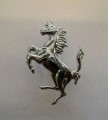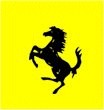






Styling
The Ferrari 360 was the 163rd Ferrari to be designed by Pininfarina and combines a successful mix of innovative design elements and styling solutions inspired by classic Ferraris, such as the 268 SP, the 250 LM and Dino. The car's finely balanced proportions cleverly hide at first glance the fact that it is mid-engined, as the passenger compartment is set almost centrally between the two axles, which the distinctive rear-end treatment leaves the engine in full view beneath the rear screen.
The Ferrari 360 is the first production by Ferrari to be constructed entirely in aluminum. Chassis, bodyshell and suspension wishbones are all made from this light-weight material, allowing the engineers to provide the best overall performance and handling ever achieved in a mid-engined Ferrari, along with levels of comfort unheard of before.
Interior
The generous dimensions of the 360 allowed the designers to come up with an especially roomy cockpit. There is even space behind the seats for a couple of suitcases or a golf bag. The driving position was designed for taller than average users and considered attention was paid to improving ease of access. The interior trim is a tasteful mix of traditional and technology. The leather upholstery is combined with distinctly sporty aluminum trim which reflects the innovative chassis construction.
Chassis
The 360 chassis was designed by Ferrari and is built in collaboration with Alcoa. Highly sophisticated variable-section aluminum extrusions are welded together via 12 cast aluminum nodes providing an extra 40% in structural rigidity and a 28% weight reduction compared to the previous F355 despite a 10% increase in overall dimensions. The suspension mounting points are one-piece castings and the chassis is assembled on a CNC work station, the same technique used for the F50. The 360 Modena exceeds all the passive safety requirements imposed by world regulations while providing excellent handling traits.
Suspension
The 360's all-aluminum double wishbone suspension layout was tuned for optimum handling, stability and driving pleasure. Sophisticated suspension geometry controls pitch, roll and yaw and is backed up by electronic damping. Stability is further enhanced by Bosch integrated ABS/ASR along with ERD (braking effort correction) and MSR (torque return control) that prevents wheel lock-up when decelerating. The car is fitted with extra large 330 mm vented and cross-drilled brake discs to enhance resistance to fade without forced cooling.
Power Train
The 5-valve per cylinder V-8 engine is centrally mounted with the dry-sump lubrication system and oil tank placed, F1 fashion, on the spacer between the engine and the longitudinal gearbox. The power output is 400 bhp at 8,500 rpm (equivalent to 112 bhp/litre) - the most any naturally aspirated Ferrari V8 engine has ever delivered.
The power unit features a variable geometry intake manifold, variable valve timing, titanium con-rods, forged aluminum pistons, Bosch ME 7.3 dual engine management and drive-by-wire throttle. The 360 Modena comes with a choice of manual or F1-style 6-speed gearbox. With the electro-hydraulic F1 transmission, the gearbox management is integrated with that of the engine and traction control to provide maximum stability under even the hardest driving.
Aerodynamics
5,400 hours spent testing in the wind tunnel resulted in excellent Cd and CI figures without compromising the car's styling. The use of two large separate air intakes for the radiators help channel the flow of air beneath the car's underside to the two rear diffusers to give aerodynamic ground effect.
Down-force increases as speed rises and at 180 mph there is an impressive 396 lbs pressing down on the car, evenly distributed between the two axles.
This results was achieved without aerodynamic aids that would have ruined the line of the car and it also enhances safety by increasing the natural load on the steering as the car picks up speed.
Source - Ferrari
The Ferrari 360 went into production in 1999 and served as a replacement for the F355. The name 'Modena' was used after the birthplace of Enzo Ferrari. The styling was courtesy of Pininfarina and mounted mid-ship was an eight-cylinder engine constructed entirely of aluminum. The engine was mounted to a six-speed gearbox available as a manual or F1 electro-hydraulic shift. Production continued until 2005 when it was replaced with the F430.
The engine produced around 400 horsepower and could carry the 2840 pound vehicle from zero-to-sixty in just 4.3 seconds. Top speed was achieved at 185 mph. Performance was improved with the introduction of the Challenge Stradale. This was a stripped-down performance version that was void of amenities and non-essential items. The aerodynamics were improved slightly; the chassis was constructed of aluminum. The engine, suspension, and brakes were all greatly improved. With 425 horsepower available and now weighing just 2600 pounds, the Ferrari 360 Challenge Stradale could go from zero-to-sixty in a mere 4.1 seconds. The overall top speed improved slightly, now at 186 mph.
In 2000 Ferrari introduced the 360 Challenge Series which gave privateers an opportunity to race modified Ferrari's in a regulated environment. The cars that competed in this series were dubbed the Ferrari 360 Challenge. They featured 18 inch BBS alloy wheels and a lowered ride height. A F1-gearbox was matted to the stock engine. The engines were sealed as to not allow tampering. The F1-gearbox is very quick, with gearshifts taking only 150 milliseconds. The suspension was improved to handle the tough track environment. The electronic damping system was replaced with Boge shock absorbers.
The FERRARI 360 History:



